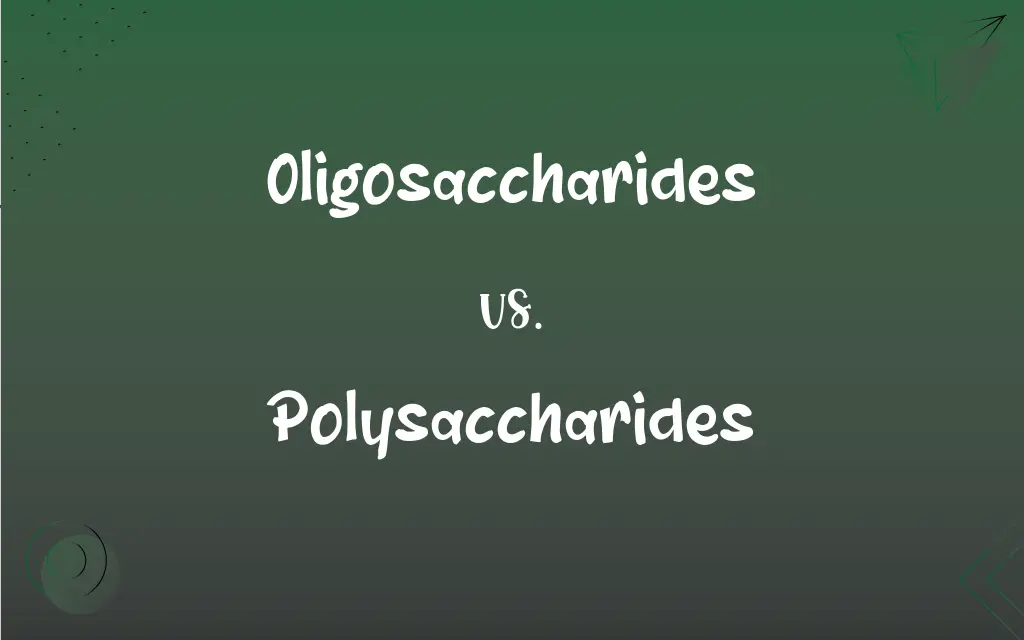Oligosaccharides vs. Polysaccharides: What's the Difference?
Edited by Aimie Carlson || By Janet White || Published on December 27, 2023
Oligosaccharides are carbohydrates with a few sugar units, while polysaccharides are long chains of numerous sugar units.

Key Differences
Oligosaccharides consist of a small number (typically 3-10) of sugar molecules linked together. Polysaccharides, in contrast, are larger molecules made up of many sugar units, ranging from a few hundred to thousands.
Oligosaccharides often function in cell recognition and are found in small quantities in foods. Polysaccharides serve as energy storage (like starch) or structural components (like cellulose) in plants and animals.
The smaller size of oligosaccharides allows them to be easily soluble in water and useful in various biological processes. Polysaccharides, due to their larger size, can be either soluble or insoluble, affecting their role in dietary fiber and energy storage.
Oligosaccharides are known for their prebiotic properties, promoting beneficial gut bacteria. Polysaccharides, on the other hand, are crucial in providing sustained energy and are key components in the human diet.
Oligosaccharides are characterized by their few sugar units and specific functions in biology and nutrition, whereas polysaccharides, with their long chains of sugars, play major roles in energy storage and structural integrity in organisms.
ADVERTISEMENT
Comparison Chart
Number of Sugar Units
Typically 3-10 units.
Hundreds to thousands of units.
Function in Organisms
Cell recognition, prebiotic properties.
Energy storage, structural support.
Solubility
Generally more soluble in water.
Varies from soluble to insoluble.
Common Sources
Found in various foods in small quantities.
Common in plants as starch, cellulose.
Role in Nutrition
Aid in digestive health, less energy contribution.
Major source of energy, dietary fiber.
ADVERTISEMENT
Oligosaccharides and Polysaccharides Definitions
Oligosaccharides
Small carbohydrates important for cell signaling.
Plant-derived oligosaccharides play a role in cell recognition.
Polysaccharides
Large molecules storing energy in living organisms.
Glycogen, a polysaccharide, stores energy in animal tissues.
Oligosaccharides
Soluble fibers with various health benefits.
Dietary oligosaccharides help regulate blood sugar levels.
Polysaccharides
Complex carbohydrates forming structural components in plants.
Cellulose, a polysaccharide, provides structural support in plant cell walls.
Oligosaccharides
Short chains of monosaccharides.
Oligosaccharides in human milk support infant development.
Polysaccharides
Long chains of monosaccharide units.
Starch, a polysaccharide, is a major energy source in diets.
Oligosaccharides
Carbohydrates composed of a few sugar units.
Fructooligosaccharides in onions enhance gut health.
Polysaccharides
Biochemically significant macromolecules in nature.
Chitin, a polysaccharide, forms the exoskeleton of arthropods.
Oligosaccharides
Prebiotic substances improving intestinal flora.
Oligosaccharides in legumes promote beneficial gut bacteria.
Polysaccharides
Insoluble fibers aiding in digestive health.
Polysaccharides in whole grains contribute to dietary fiber.
Oligosaccharides
A carbohydrate that consists of a relatively small number of monosaccharides.
Polysaccharides
Any of a class of carbohydrates, such as starch and cellulose, consisting of a number of monosaccharides joined by glycosidic bonds.
Oligosaccharides
Plural of oligosaccharide
Polysaccharides
Plural of polysaccharide
FAQs
What are oligosaccharides?
Oligosaccharides are carbohydrates made of a few (3-10) sugar units.
How do oligosaccharides benefit health?
Oligosaccharides act as prebiotics, promoting healthy gut bacteria.
What is the primary role of polysaccharides?
Polysaccharides primarily serve as energy storage and structural components.
Are oligosaccharides found in human milk?
Yes, human milk contains oligosaccharides important for infant growth.
What are polysaccharides?
Polysaccharides are large carbohydrates composed of many sugar units.
Where are polysaccharides commonly found?
Polysaccharides are found in plants as starch and cellulose, and in animals as glycogen.
Do oligosaccharides have a sweet taste?
Some oligosaccharides have a mildly sweet taste.
Are polysaccharides soluble in water?
Polysaccharide solubility varies; some are soluble, while others, like cellulose, are insoluble.
How do polysaccharides provide energy?
Polysaccharides like starch are broken down into glucose for energy.
What's the difference in structure between oligosaccharides and polysaccharides?
Oligosaccharides have shorter chains of sugar units compared to the long chains in polysaccharides.
Can oligosaccharides cause digestive issues?
In some people, excessive intake of oligosaccharides can lead to gas or bloating.
How do oligosaccharides affect blood sugar?
Oligosaccharides can help regulate blood sugar levels due to their fiber content.
Are oligosaccharides considered dietary fiber?
Oligosaccharides are a type of soluble fiber.
What makes polysaccharides different from simple sugars?
Polysaccharides are complex sugars with long chains, while simple sugars have shorter structures.
Can oligosaccharides be digested?
Oligosaccharides are not fully digested; they ferment in the gut, aiding digestion.
Are all oligosaccharides prebiotic?
Many oligosaccharides function as prebiotics, but not all.
Are polysaccharides important in a balanced diet?
Yes, polysaccharides are essential for a balanced diet, providing energy and dietary fiber.
Can polysaccharides be used in industry?
Yes, polysaccharides have industrial applications, including in food production and textiles.
What is the impact of polysaccharides on cholesterol?
Some polysaccharides can help lower cholesterol levels.
Do oligosaccharides improve nutrient absorption?
Oligosaccharides can enhance mineral absorption and gut health.
About Author
Written by
Janet WhiteJanet White has been an esteemed writer and blogger for Difference Wiki. Holding a Master's degree in Science and Medical Journalism from the prestigious Boston University, she has consistently demonstrated her expertise and passion for her field. When she's not immersed in her work, Janet relishes her time exercising, delving into a good book, and cherishing moments with friends and family.
Edited by
Aimie CarlsonAimie Carlson, holding a master's degree in English literature, is a fervent English language enthusiast. She lends her writing talents to Difference Wiki, a prominent website that specializes in comparisons, offering readers insightful analyses that both captivate and inform.







































































